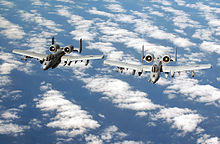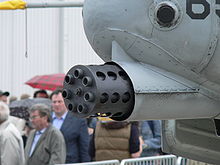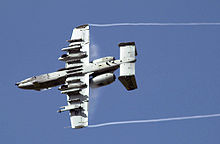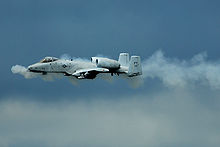Fairchild-Republic A-10
| Fairchild Republic A-10 Thunderbolt II | |
|---|---|
 An A-10A "Thunderbolt II" of the 52nd Fighter Wing |
|
| Type: | Ground attack aircraft |
| Design country: | |
| Manufacturer: | |
| First flight: |
May 10, 1972 |
| Commissioning: |
March 1977 |
| Production time: |
1975 to 1986 |
| Number of pieces: |
715 |
The Fairchild-Republic A-10 Thunderbolt II (German thunderbolt ), also by their pilot Warthog ( " Warthog ") or short Hog called, is since 1975 the main ground attack aircraft of the US Air Force .
The simply structured, effective and robust twin-jet subsonic jet is intended for use against ground targets, especially for fighting armored vehicles . In addition, it was used as the OA-10 in the function of a flying fire control station.
The name Thunderbolt II picks up on the name of the Republic P-47 Thunderbolt , which was used as a fighter aircraft in World War II and later as a fighter-bomber by the US Army Air Forces .
The only permanent stationing location of an A-10 squadron in Germany , which also used the A-10C from 2009, was Spangdahlem Air Base between January 1993 and May 2013 after the end of the Cold War . In the first year this was the 510th and from spring 1994 the 81st Fighter Squadron . In February 2015, a total of 12 of these aircraft were relocated back to Spangdahlem.
history
development
The A-10 was developed within the US Air Force's Attack Experimental (AX) program, which was initiated in June 1966 to find a suitable successor to the Douglas A-1 . This was characterized by a relatively simple, robust construction, but could carry a large weapons load, making them particularly suitable for the task of close air support - suitable (Close Air Support CAS). On March 6, 1967, the Air Force addressed a call for drafts to 21 companies. The US Air Force's demand also had the political background that it represented a counterweight to the efforts of the US Army and US Marine Corps, which were each trying to enforce their own procurement of CAS aircraft.
Was with the first drafts still in most cases, a design with two turboprop engines provided they waved from 1969 to turbofan engines with a high bypass ratio to. On May 7, 1970 twelve manufacturers received an invitation to submit offers based on a unit price of 1.4 million US dollars with a production volume of 600 machines. Boeing, Cessna, Fairchild, General Dynamics, Lockheed and Northrop made offers, after which Northrop and Fairchild-Republic were declared the winners on December 18, 1970. Both companies received the associated contract to build two prototypes. On March 1, 1971, both models received their official designations Northrop YA-9 and Fairchild-Republic YA-10. The first YA-10 flew on May 10, 1972, the YA-9 followed on May 30, 1972.
The formal evaluation of the prototypes by five pilots from the Tactical Air Command and the AFSC lasted from October 10 to December 9, 1972, with the first prototype being flown 307.6 hours and the second 328.1 hours. The design of the A-10 prevailed against the competition. Under pressure from the US Congress , which insisted that the A-10 should also carry out a comparison flight against the Vought A-7 D, the funds for four YA-10A were temporarily cut. The flights with both aircraft were conducted in April and May 1974 at McConnell AFB , with four Air Force pilots using the second YA-10 against an A-7D. The YA-10 won mainly because of its longer dwell time of two hours at a distance of 480 km from the base, the A-7 was only able to guarantee this for eleven minutes. If the proposed A-7DER had been procured, the A-7D would have had a longer fuselage, a new engine and the GAU-8 Avenger cannon.
The first production-ready A-10A were delivered to Davis-Monthan Air Force Base in Arizona in October 1975 . In the 1980s, operational tactics stipulated that the A-10 should disrupt enemy tank divisions in the event of a Soviet attack on West Germany . In constant rotation, a number of the 108 A-10A aircraft of the 81st Tactical Fighter Wing stationed in England on the neighboring bases RAF Bentwaters and Woodbridge were relocated to so-called Forward Operating Locations (FOL) in western Germany: Ahlhorn , Nörvenich , Sembach and Leipheim .
commitment
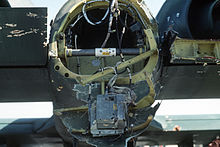
During Operation Desert Storm in 1991 over Iraq , the A-10 achieved a reliability of 95.7 percent. They flew 8,100 sorties and launched 90 percent of the AGM-65 Maverick missiles fired in that war . The Thunderbolt II planes destroyed over 1,000 tanks, 2,000 military vehicles and 1,200 artillery pieces. An A-10 also achieved its first aerial victory of this type when an Iraqi Bo 105 was shot down with an on-board cannon. A total of two kills by Iraqi helicopters have been confirmed. Five A-10s were lost - far fewer than the military planners expected.
In 1999 A-10 were involved in NATO's air offensive in the war in Kosovo . However, they were only used cautiously to avoid US losses, which prevented the machines from being used effectively. During the US invasion of Afghanistan in 2001, the A-10 were initially out of action, but were later stationed at Bagram Air Force Base and participated in attacks on Taliban positions, including Operation Anaconda in March 2002. As a result of less restrictive rules of attack the planes performed better there.
In 2003 the A-10 flew a second time over Iraq as part of the Third Gulf War . 60 A-10s were stationed in the Gulf, one of which was lost to Iraqi defensive fire near Baghdad Airport towards the end of the fighting .
When the US Air Force announced plans to take the A-10 out of stock in 2004, the US Army immediately offered to take over the aircraft. However, this would have required an amendment to the 1947 partition agreement between the Army and Air Force, which states that the Army may not use fixed-wing aircraft, but only helicopters.
As part of budget cuts, the US A-10 fleet, which previously consisted of 365 active aircraft, was significantly reduced (five squadrons were decommissioned - effective from budget year 2013). As part of an update program, the 242 machines remaining in active service will receive new wings (manufacturer Boeing), which are designed for a service life of 10,000 flight hours and should make the fleet usable by 2040. A replacement by the F-35 is currently not planned and is ruled out by leading US military planners. It is likely that the A-10 will be replaced by an unmanned successor. In February 2010, DARPA officially received an order for the development of an unmanned successor model for the A-10.
future
The comparatively low costs are one reason why the A-10 continues to be in use despite its now quite long service life. It forms the backbone of the US air force when fighting armored vehicles with a long approach time to the area of operation. The AH-64 Apache attack helicopter, which is also used to combat armored units, has a much shorter range, cannot be air-fueled and is much less resistant to fire.
Considerations to replace the A-10 with a version of the F-16 specialized in ground combat were abandoned after field tests during Operation Desert Storm . The F-16 received external containers (pods) with a modified five-barrel automatic cannon, as it is similarly used in the A-10. When firing, however, the entire aircraft was set in strong vibrations, so that targeted shooting became impossible and damage to the aircraft's airframe was feared. The experiments were stopped after only two days. There is currently no aircraft that could replace the A-10 in its field of activity. When Iraqi prisoners of war were interviewed, it emerged that the A-10 was, alongside the Boeing B-52, the most feared Allied aircraft over the Middle Eastern battlefield.
On February 24, 2014, Secretary of Defense Chuck Hagel gave a speech in which he presented a cost-cutting program, including a plan to decommission the entire A-10 fighter fleet. According to the Chief of Staff of the United States Air Force , General Mark Welsh , with the closure of about 300 A-10 to 2019, a sum of 4.2 billion dollars could be saved. However, in a vote on June 19, the US House of Representatives blocked the decommissioning of the A-10. On June 20, the 'Defense bill' passed the House of Representatives - with an appendix on the A-10. In mid-January 2016, it became known that the Air Force was putting its plans to retire the A-10 on hold for an indefinite period of time, as the machine plays a key role in the ongoing mission against IS.
Losses outside of war operations
- On June 4, 1977, on the opening day of the Paris Aérosalon, an A-10 crashed due to a loop that had flown too low. Fairchild's chief test pilot Howard W. Nelson dies a little later in the rescue helicopter during the flight to the hospital.
- On December 8, 1988 , an A-10 of the 81st Tactical Fighter Wing of the US Air Force crashed into a residential area during a squadron exercise. This accident left seven dead and 50 injured. 120 residents and rescuers with skin diseases have come forward. The diseases were classified as toxic-irritative dermatitis.
- On January 20, 1999, an A-10 of the Air National Guard's 104th Fighter Wings crashed into a wooded area near Williamsburg, New York . The pilot was able to prevent a crash in an inhabited area and saved himself with the ejection seat.
- On September 3, 2001, an A-10 of the 23rd Fighter Group crashed in the Virgin River Gorge near the state border of Utah and Arizona; the pilot was able to save himself. Due to the events of September 11, 2001 , debris from the crash can still be found today, as the clean-up work was canceled.
- On December 4, 2002, two A-10s collided while training about 150 km northwest of Las Vegas over the Nellis Test and Training Range . One pilot died, the other was able to save himself with the ejection seat.
- On April 1, 2011 at 3:45 p.m., an A-10 crashed in an open field near Laufeld near Manderscheid . The pilot was able to avert a crash on the site and save himself with the ejection seat. The A-10 was launched from the MOB Spangdahlem Air Base .
construction
The pilot is protected by a 400 kg heavy titanium armor, which also covers parts of the avionics . The armor is called "The Bathtub" by pilots because of its shape. Important structural elements are designed redundantly in order to enable the onward flight after a fire: The fuel tanks are self-sealing and designed in such a way that they do not explode if hit; the hydraulic control is designed to be double redundant and has a mechanical emergency system (triple redundant) which enables control in the event of a hydraulic failure. The engines are placed as far apart as possible to minimize the risk of simultaneous destruction. Their arrangement behind / above the wings reduces the risk of damage from defensive fire against the aircraft in flight. The A-10 is nevertheless a comparatively easy target for surface-to-air missiles because of its low speed.
Maintenance is made easier because many parts can be used on both sides, including the engines, main landing gear and vertical stabilizers . The fuel supply is mainly transported in the fuselage; only a small part in integral tanks ( wet wing ) in the wings. This tank arrangement reduces the moment of inertia about the vertical axis and longitudinal axis. The maneuverability increases, but also the load on the wing root .
The A-10 can operate at low altitude below 300 m (1000 ft ) with a range of 2.4 km and is particularly agile for this purpose. The large operational radius and the short take-off and landing capabilities allow operations from temporary bases near the front. Night vision devices enable missions in the dark.
The cockpit has a full-view hood to improve all-round visibility . Basically, it is inferior to enemy fighters, as these could usually shoot down an A-10 with long-range air-to-air missiles before the A-10s with their superior cannon armament or the optional AIM-9 "Sidewinder" missiles could fight back. That is why today, as a rule, care is taken to ensure that the A-10 are protected by a sufficient number of fighters.
Avionics equipment includes communication devices, an inertial navigation system , fire control systems , aiming aids and night vision devices. A head-up display (HUD) shows the pilot flight and navigation data. The LASTE system ( Low Altitude Safety and Targeting Enhancement system ) continuously calculates the point of impact of ballistic bombs (CCIP) and displays it on the HUD to increase target accuracy. The A-10 has automatic countermeasures against attacks with infrared or radar-guided surface-to-air missiles . All A-10 are currently being retrofitted with GPS .
The A-10 has no stealth capabilities , but is relatively quiet thanks to its turbofan engines; its camouflage pattern gives it a good visual camouflage, especially at night .
Versions

- YA-10A
- Pre-production version. Twelve pieces built.
- A-10A
- Single-seat version for ground attack and air support.
- OA-10A
- Renaming of older A-10A, which should be used as a fast "Forward Air Controller". No modifications were made, only the equipment carried is reduced to target marker missiles. Should serve as the successor to the OA-37B and Rockwell OV-10 A.
- YA-10B Night / Adverse Weather
- Single experimental two-seater prototype for use at night and in bad weather. Converted from an A-10A.
- A-10C
- modernized A-10A for the Gradual Precision Engagement (PE) program. For this purpose, a digital weapon management system with a new central computer, data link SADL (Situation Awareness Data Link) with connection to Link-16 data link and MIL-STD-1760 data bus was installed, new weapons (JDAM, WCMD) and the target containers Northrop Grumman Litening AT and Lockheed Martin Sniper XR integrated. A new cockpit with two 13 × 13 cm color screens and HOTAS controls was also installed. In order to meet the increased requirements for electrical power, a second generator was installed at the same time.
Technical specifications
| Parameter | A-10A Thunderbolt II data |
|---|---|
| crew | 1 pilot |
| length | 16.26 m |
| span | 17.42 m |
| height | 4.42 m |
| Wing area | 47.01 m² |
| Wing loading |
|
| Empty mass | 9,761 kg |
| normal takeoff mass | 14,846 kg |
| Max. Takeoff mass | 22,680 kg |
| Max. Fuel capacity | 4,853 kg (internal) |
| Top speed | 706 km / h (at sea level) |
| Minimum speed | approx. 220 km / h (at sea level) |
| Rate of climb | 1,828 m / min |
| Service ceiling | 13,636 m |
| Use radius | 1,030 km |
| Transfer range | 4,091 km |
| Engine | 2 × General Electric TF34 -GE-100 turbofan engines |
| Thrust | 2 × 40.32 kN |
| Thrust-to-weight ratio |
|
| Max. Gun load | 7,257 kg |
| Unit price | approx. $ 11.7 million (average) |
| status |
|
Armament
Permanently installed on-board cannon
- 1 × 30 mm Gatling automatic cannon GAU-8 / A Avenger with 1350 rounds of ammunition . You verschießt explosive grenades and armor-piercing ammunition with uranium core with a cadence of 4200 rounds per minute (mass per grenade up to 750 g). The recoil force of the weapon is 44.5 kN , which is more than the thrust of one of the engines.
External load stations
- Explosive ordnance up to 7,257 kg at eleven external load stations
- Air-to-air guided missile
- 1 × LAU-114 / A double runner support for each 2 × Raytheon AIM-9M-9 / L "Sidewinder" - infrared controlled for short distances
- Air-to-surface guided missile
- 2 × LAU-88A triple-entry guide rails for 3 × Raytheon AGM-65A / B / D / G "Maverick" - infrared or tv-controlled
- 2 × LAU-117A starter rails for 1 × Raytheon AGM-65A / B / D / G "Maverick" - infrared or tv-controlled
- 2 × AGM-114 Hellfire air-to-surface missile for anti-tank defense .
- Unguided missiles
- 4 × rocket tube launch container LAU-68 / A (for 7 × unguided Hydra-FFAR air-to-surface rockets each ; caliber 70 mm / 2.75 inch)
- 4 × rocket tube launch container LAU-5002 (7 × unguided CRV7 air-to-surface rockets; caliber 70 mm / 2.75 inch)
- 4 × rocket tube launch container LAU-61 / A (each for 19 × unguided Hydra-FFAR air-to-surface rockets; caliber 70 mm / 2.75 inch)
- 4 × rocket tube launch container LAU-5003 (19 × unguided CRV7 air-to-surface rockets; caliber 70 mm / 2.75 inch)
- 6 × rocket tube launch container LAU-10B / A (4 × unguided Zuni air-to-surface rockets; caliber 127 mm / 5 inch)
- Guided bombs
- 2 × GBU-10 / B Paveway II (laser-guided bomb; 907 kg)
- 4 × GBU-12 / B Paveway II (laser-guided bomb; 227 kg)
- 5 × GBU-54 Joint Direct Attack Ammunition (JDAM, laser and satellite navigation- guided 227 kg bomb)
- 2 × GBU-16 / B Paveway II (laser-guided bomb; 496 kg)
- 2 × GBU-24 / B Paveway III (laser-guided bomb; 1050 kg)
- Unguided free-fall bombs
- 10 × Mark 82 LDGP (227 kg / 500 lb free fall bomb )
- 6 × Mark 83 LDGP (454 kg / 1000 lb free fall bomb)
- 2 × Mark 84 LDGP (907 kg / 2000 lb free fall bomb)
- 2 × Mk.77 Mod 2 (230 kg / 500 lb napalm firebomb)
- 8 × BLU-1 / B (340 kg / 750 lb napalm B bomb)
- 8 × BLU-27 / B (340 kg / 750 lb napalm B bomb)
- 8 × Mark 20 "Rockeye II" (CBU-100) (222 kg / 490 lb anti-tank cluster bomb with 247 Mk.118 bomblets)
- 4 × Hunting Engineering BL755 (264 kg anti-tank cluster bomb with 7 × 21 bomblets)
- 4 × CBU-52 / B (350 kg / 770 lb cluster bombs with 217 submunitions)
- 4 × CBU-58 / B (370 kg / 815 lb cluster bomb with 650 submunition units)
- 4 × CBU-71 / B (370 kg / 815 lb cluster bomb with 650 submunition units)
- 4 × CBU-87 / B (430 kg / 950 lb cluster bomb with 202 submunition units)
- 4 × CBU-89 / B "Gator" (320 kg / 700 lb cluster bomb with 94 submunition units)
- 4 × CBU-97 / B Sensor-Fuzed Weapon (416 kg / 914 lb cluster bomb with 10 submunition units)
- Additional container
- 2 × luminous torch launcher SUU-40 / A with 4 x Mk.24- flares
- 2 × flare throwers SUU-44 / A with 8 × Mk.45 flares
- 2 × drop-off Sargent-Fletcher additional tanks for 2271 liters of kerosene
- 2 × CNU-188 / A luggage containers
A-10C only
- Guided bombs
- 4 × CBU-105 Wind Corrected Ammunition Dispenser (A-10C only)
- 4 × GBU-31 JDAM ( Joint Direct Attack Ammunition , 907 kg)
- 4 × GBU-38 JDAM (Joint Direct Attack Ammunition, 227 kg)
Self protection
- Active measures
- 1 × AN / ALQ-119 (V) ECM canister
- 1 × AN / ALQ-131 (V) -ECM container
- 1 × AN / ALQ-184 (V) -1 ECM container
- 16 × flare launchers AN / ALE-40 with 15 flare cartridges each (e.g. MJU-7A / B heat flares with a width and length of 38 mm)
- 1 × AN / ALE-37 / A external decoy launcher container with 120 decoy cartridges (e.g. MJU-8A / B heat flares with 38 mm width and length)
- 4 × SUU-25C / A decoys (launcher for four unguided rockets with parachute deceleration)
- Passive action
- 3 × AN / ALR-46 (V) radar warning receiver
- 4 × AN / ALR-69 (V) radar warning receiver
Sensors
The best sensor for target acquisition on the A-10 until 2005 was the pilot's good eye. From variant A-10C, external containers with search sensors were carried along.
- 1 × " Pave Penny " laser finder (enables the location of laser-marked ground targets)
- 1 × Lockheed-Martin AN / AAQ-33 "Sniper-ATP" aiming aid container (A-10C only)
- 1 × Rafael / Northrop Grumman AN / AAQ-28 (V) "Litening-AT" target light container (A-10C only)
See also
literature
- Steve Davis: A-10 Thunderbolt. Motorbuch Verlag, Stuttgart 2018, ISBN 978-3-613-04042-7 .
Web links
- Information at globalsecurity.org (English)
Individual evidence
- ↑ "Warthogs" leave Spangdahlem. In: Saarbrücker Zeitung. May 18, 2013, accessed March 29, 2014 .
- ↑ Rick Stephens: A-10 Fighting Warthog. In: World Airpower Journal, Vol. 16, p. 34.
- ↑ Rick Stephens: A-10 Fighting Warthog. In: World Airpower Journal, Vol. 16, p. 37.
- ↑ Militarization Atlas of the Federal Republic, ed. v. Alfred Mechtersheimer u. Peter Barth, 3rd edition, Darmstadt 1988, pp. 35/36.
- ↑ a-10.org: Warthog Territory. (No longer available online.) Archived from the original on November 19, 2010 ; accessed on August 21, 2020 .
- ↑ Flight Global: DARPA launches search for unmanned A-10 replacement , February 11, 2010
- ^ Secretary of Defense Speech: Fiscal Year 15 Budget Preview
- ↑ Johannes Korge: Sparzwang: USA are planning the smallest army since the Second World War. SPIEGEL ONLINE , February 24, 2014, accessed on February 24, 2014 .
- ↑ Jon Hemmerdinger: Grounding A-10s will save $ 4.2 billion, decision 'clear': USAF general. (No longer available online.) In: Flightglobal.com. April 23, 2014, archived from the original on April 24, 2014 ; Retrieved on August 21, 2020 : "The service's fiscal year 2015 budget proposal, which requires Congressional approval, proposes grounding all of its roughly 300 A-10s at a savings Welsh estimates to be $ 4.2 billion through fiscal year 2019."
- ↑ Stephen Trimble: US House approves defense spending bill, blocks A-10 retirement . In: Flightglobal.com. June 20, 2014, accessed on June 22, 2014 (English): “The US House of Representatives voted on June 19 to block a US Air Force proposal to retire the Fairchild Republic A-10 attack fighter next year. By approving the A-10 amendment filed by Representative Candice Miller by a 300-114 vote, the full membership of the House also thwarted a previous vote by the defense appropriations committee to retire the close air support specialist. "
- ^ Defense Bill Passes House, Includes Amendment Supporting A-10
- ↑ Marcus Weisgerber: Air Force to Delay A-10 Retirement, Thanks to ISIS. In: Defense One. January 13, 2016, accessed on January 17, 2016 (English): "The Air Force is shelving its immediate plans to retire the A-10 Warthog attack plane, which has become critical to the US bombing campaign against Islamic State militants in Iraq and Syria, Pentagon officials tell Defense One. "
- ↑ George Vecsey: Plot Killed in Crash of US Plane At Opening Day Of Paris Air Show. New York Times , June 4, 1977, accessed October 10, 2019 .
- ↑ 20 years ago: US fighter plane crashes over Remscheid. Inferno with controversial consequences. WDR , December 8, 2008, accessed August 13, 2013 .
- ↑ wz.de: Plane crash in Remscheid in 1988: The shock is still deep , December 8, 2008
- ↑ Williamstown Fire Department: Air National Guard A-10 Thunderbolt II "Warthog" Crashes in Williamstown , accessed April 2, 2011
- ↑ reviewjournal.com: Fighter jet crashes; pilot ejects to safety ( memento of January 12, 2012 in the Internet Archive ), accessed on April 2, 2011
- ^ Archives.cnn.com: Air Force plane crashes near Utah-Arizona line , accessed April 2, 2011
- ↑ waymarking.com: A-10 Warthog crash site , accessed April 2, 2011
- ↑ globalsecurity.org: A-10 crash kills pilot , accessed April 2, 2011
- ↑ focus.de: Rhineland-Palatinate: US fighter jet crashes in the Vulkaneifel , accessed on April 1, 2011
- ↑ eifel-journal.de: Laufeld: Thunderbolt crashed ( page no longer available , search in web archives ) Info: The link was automatically marked as defective. Please check the link according to the instructions and then remove this notice. , accessed April 1, 2011
- ^ Abendblatt.de: Jet fighter crashes 300 meters from the village in the Eifel , accessed on April 1, 2011
- ↑ Henderson, Breck W .: A-10 'Warthogs' damaged heavily in Gulf War bug survived to fly again. Ed .: Aviation Week and Space Technology. 5th August 1991.
- ↑ Donald and March 2005, pp. 9-10.
- ↑ Jenkins 1998, pp. 92-93.
- ↑ FlugRevue January 2010, pp. 38–42, Modern Times - A-10C of the USAF with new systems

